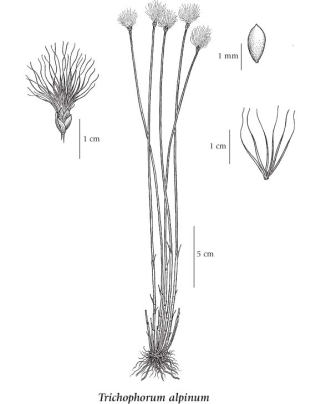Trichophorum alpinum (L.) Pers.
Hudson Bay clubrush (alpine bulrush)
Cyperaceae (Sedge family)
Introduction to Vascular Plants
Hudson Bay clubrush (alpine bulrush)
Cyperaceae (Sedge family)
Introduction to Vascular Plants
Introduction
Alpine clubrush (a.k.a.) alpine cotton-grass, is a native, perennial rhizomatous species that is found in North America at higher latitudes. It is a distinctive circumpolar peatland species which typifies sites of mineral enrichment, where it occurs with other mineral-loving species such as cattails. In BC, it is found across the province, exclusive of the coast islands, in bogs, swamps, fens and wet meadows in the montane and subalpine zones. Flowers occur in solitary spikes. Alpine cotton-grass differs from true cotton-grasses (genus Eriophorum) in having few (6-8) bristles, while cottongrasses typically have lots of bristles.
View a video of this species in the field, with Tony Reznicek
|
Species Information
General:
Perennial herb from short, freely rooting rhizomes; stems more or less densely clustered, in rows, sharply triangular in cross-section, rough on the angles, (5) 10-40 cm tall.
Leaves:
More or less reduced, scalelike at the base of the stems, with 1 or sometimes 2, more normally-developed leaves above the base; sheaths straw-coloured to brownish, not cross-wrinkled; blades narrow, 5-12 mm long, rough on the margins, the hairs directed forward or upward, the tips firm, blunt, somewhat expanded and cartilaginous.
Flowers:
Spikes solitary, terminal, medium or light brown, 5-7 mm long, many-flowered; involucral bracts lacking.
Fruits:
Scales 2 or 3, chestnut, lanceolate to egg-shaped, blunt, the lowermost egg-shaped, up to as long as the spikes, with prominent, thickened midribs which are exserted as broad, blunt awns or small, short, abrupt points, 0.5-2 mm long; perianth bristles 6, white, flattened, smooth, crisped, elongate, much surpassing the scales, at maturity forming silky white tufts extending 1-2.5 cm beyond the end of the spikes; achenes purplish-brown, 3-angled, narrowly egg-shaped, about 1.5 mm long, minutely abruptly sharp-pointed.
Illustration

If more than one illustration is available for a species (e.g., separate illustrations were provided for two subspecies) then links to the separate images will be provided below. Note that individual subspecies or varietal illustrations are not always available.
Illustration Source: The Illustrated Flora of British Columbia
Ecology
Ecological Framework for Trichophorum alpinum
The table below shows the species-specific information calculated from
original data (BEC database) provided by the BC Ministry of Forests and Range.
(Updated August, 2013)
The table below shows the species-specific information calculated from
original data (BEC database) provided by the BC Ministry of Forests and Range.
(Updated August, 2013)
| Site Information |
Value / Class |
||
|
Avg |
Min |
Max |
|
| Elevation
(metres) |
854 | 560 | 1980 |
| Slope
Gradient (%) |
0 | 0 | 15 |
|
Aspect (degrees) |
343 | 40 | 286 |
| Soil
Moisture Regime (SMR) [0 - very xeric; 4 - mesic; 8 - hydric] |
6 | 3 | 8 |
| Modal
Nutrient Regime
Class |
C | ||
| #
of field plots species was recorded in: |
45 | ||
| Modal
BEC Zone Class |
SBS | ||
|
All BEC Zones (# of stations/zone) species was recorded in |
ESSF(1), ICH(7), MS(3), SBS(32) | ||
|
Source:
Klinkenberg 2013
|
|||
Habitat and Range
Bogs, swamps, fens and wet meadows in the montane and subalpine zones; infrequent in BC east of the Coast Mountains; circumpolar, N to AK, YT and NT, E to NF and S to ME, MA, NY, MI, MN, MT and ID; Eurasia.Status Information
Synonyms
Synonyms and Alternate Names:
Baeothryon alpinum (L.) Egor.
Eriophorum alpinum L.
Leucocoma alpina (L.) Rydb.
Scirpus hudsonianus (Michx.) Fernald